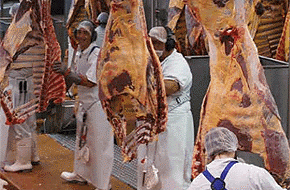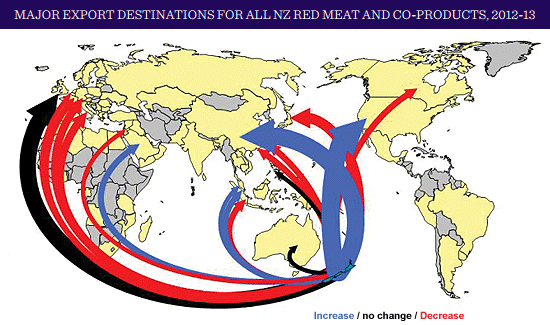
By Allan Barber
The Meat Industry Association has recently published its 2013 Annual Report which contains an honest assessment of the challenges of the past year and a summary of the positive initiatives under way.
The 2012/13 year took place against a background of unsatisfactory farmer returns and heavy losses by processors during the previous season.
Although the total value of exports actually increased compared to the previous year, this was mostly because of drought-induced slaughter volumes. This of course will have a depressing effect on future sheep and beef numbers.
Volatility
The report acknowledges the volatility inherent in the meat industry and highlights a number of factors which influence this, including weather conditions, their impact on timing of supply and production numbers, mismatch between supply of livestock and sale of product, uncertainty of supply and market returns, competition from cheaper proteins, changing marketing environment, New Zealand’s small global scale, and the need to sell the whole carcase at a profit.
Much of this volatility is inevitable, but the report states the existing industry model makes it even worse.
As many have said for as long as I can remember, lack of certainty of supply makes it difficult to guarantee certainty of supply to overseas customers, resulting in a loss of value to New Zealand (both farmers and processors).
Industry over-capacity is only one factor which detracts from stable procurement and supply and as a consequence reduces profitability.
Farmer perceptions
The loss of value and volatility of returns lie at the heart of farmers’ complaints about industry structure and their perceived inability to influence what they earn for their beef and sheepmeat. I use the term ‘perceived’ deliberately because, within limits, there are plenty of ways farmers can influence their returns, even if not to the extent they would like.
MIA’s report stresses processors and farmers must work together more closely to find and implement solutions which require a longer term perspective in both procurement and marketing.
Mutual commitment would permit the development of longer term relationships with overseas customers, particularly retailers, to the benefit of both farmers and export processors.
Better communication and understanding between producer and processor will assist achievement of at least two of the stated goals of the Red Meat Sector Strategy: aligned procurement (supply what and when the market demands and eliminate third parties) and best practice production, processing and marketing.
Balance of markets
Another key point is the need to maintain a balance of markets and avoid putting too many eggs in one basket.
Market conditions and market access can change suddenly, as has already happened this year with China, although it is now New Zealand’s second biggest sheepmeat and beef market after the EU and USA respectively.
Importance of co-products
A fact which is often forgotten or ignored in the debate over lamb and beef prices is the significant contribution from co-products, excluding wool, which make up nearly a quarter of total meat exports.
In case farmers imagine meat processors get the co-products free when they buy the livestock, they play an important part in calculating the procurement schedule. Hides and skins make up 36% of the co-product exports, hence almost 9% of the total value, while edible offal, tripe, tallow, meat and bone meal, and casings represent 55%.
No single desk or monopoly marketing structure could achieve anything remotely close to this proportion of total export value.
-------------------------------------------------------------------------------------------------------------------------------------------
Farms For Sale: the most up-to-date and comprehensive listing of working farms in New Zealand, here »
-------------------------------------------------------------------------------------------------------------------------------------------

Partnerships
MIA and B+LNZ work together on several initiatives which are closely aligned with the RMSS, in addition to MIA members involved directly in PGP programmes designed to contribute strongly to it. $200 million is being committed by the red meat sector to these projects, supplemented by a further $160 million from the government.
Key PGP programmes include Farm IQ, led by Silver Fern Farms and AgResearch, with the objective of developing product for specific consumer requirements, the Partnership for Profitability Programme initiated by B+LNZ with assistance from processors and bankers aimed at adopting best practice and more aligned procurement, and ANZCO’s Foodplus initiative to develop new, value added food products.
There is a lot happening across both these PGP projects and other industry funded programmes, such as ovine automation, improved chilled lamb shelf-life, higher value from meat and bone meal, and market access. Much of this development work tends to be under the radar and therefore not seen by producers as contributing to their returns, considered to be unsatisfactory both in absolute terms and in relation to dairy.
So while there will be frustration among some farmers at the lack of progress by meat processors towards a solution to the problems of excessive capacity, it is worth focusing on the innovative developments which are happening in the meat industry.
Longer term the capacity issue will resolve itself one way or another, although it may be painful, but there will also be some positive gains from the substantial level of investment in the future.
Meanwhile next season’s prices will be better than last.
---------------------------------------------------------------------------------------
Here are some links for updated prices for
- lamb
- beef
- deer
- wool
P2 Steer
Select chart tabs
---------------------------------------------------------------------------------------
Allan Barber is a commentator on agribusiness, especially the meat industry, and lives in the Matakana Wine Country where he runs a boutique B&B with his wife. You can contact him by email at allan@barberstrategic.co.nz or read his blog here ». This piece was first published in the Farmers Weekly and is here with permission.

We welcome your comments below. If you are not already registered, please register to comment
Remember we welcome robust, respectful and insightful debate. We don't welcome abusive or defamatory comments and will de-register those repeatedly making such comments. Our current comment policy is here.